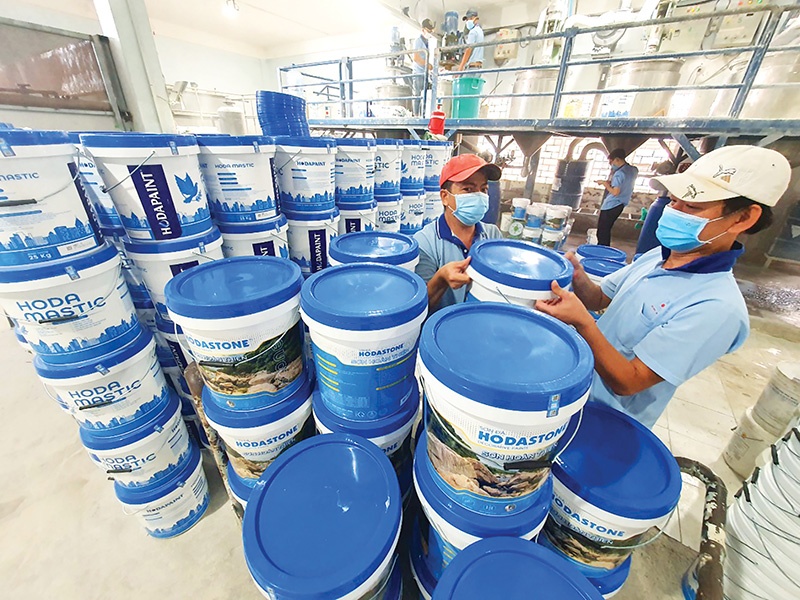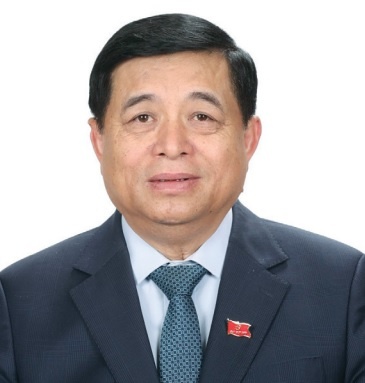Fresh policy crafted to ensure stability
 |
| Businesses are to enjoy a 2-per-cent reduction in VAT |
The National Assembly (NA) last week adopted a hallmark resolution on fiscal and monetary policy to support the national programme on socioeconomic recovery and development for 2022-2023, with an estimated value of $15 billion.
The policy, designed by the Ministry of Planning and Investment (MPI), comes in the form of further help for those affected by the ongoing pandemic. From a macro perspective, it is expected to drive the economy to a higher level of growth, at 6.5-7 per cent in 2021-2025.
The MPI said that in order to ensure sufficient capital for implementing the resolution, the government will, first and foremost, conduct radical saving of expenditure from state coffers. In addition, state budget revenue must be increased via different solutions including the boosting of tax reforms, fighting against revenue losses, transfer pricing, tax evasion, capital divestment, and equitisation of state-owned enterprises.
“After implementing these measures, if there is still a lack of capital, we will resort to the mobilisation of capital from issuance of government bonds, then from loans under official development assistance and loans from foreign donors and foreign financial institutions,” said an MPI report.
“The policy’s schemes for mobilising and disbursing capital for each year has been thoroughly calculated by the government based on the set view of firmly keeping macroeconomic stability and ensuring all major balances of the economy, and these schemes have met our requirements,” said the report, as read out by MPI Minister Nguyen Chi Dung to the NA last week. “In 2022, as much as 42 per cent of total capital of the policy will be disbursed, while the remainder coming during 2023.”
Nguyen Thi Hong, Governor of the State Bank of Vietnam, added that the mobilised capital for implementing the resolution will “largely come from domestic sources via issuance of government bonds under the form of local and foreign currencies. This also requires a concerted and close combination between monetary and fiscal policies in order to successfully mobilise this huge sum of capital.”
It is suggested that budget overspending be increased by $10.43 billion in 2022-2023.
The mobilisation of capital for this policy will increase budget overspending by another 1.2 per cent of GDP annually in 2022-2023, public debt to 49-50 per cent by late 2025, and government debt to 45-46 per cent of GDP by late 2025.
The policy covers many key components, including reopening the economy pertaining to enhancing medical capacity, and pandemic prevention and control; ensuring social welfare and employment; assisting the recovery of enterprises, cooperatives, and business households; developing infrastructure and unlocking social resources for development investment; increasing institutional and administrative reform; and improving the investment and business climate. Moreover, another $435 million will be mobilised from non-state budget financial funds.
Under the resolution, VAT for applicable goods and services will be reduced to 8 per cent in 2022, down two per cent from the existing rate, excluding goods and services in the sectors of telecoms, IT, finance and banking, insurance, stock, real estate business, metal production and mining industries (except coal), coke production, petroleum, chemicals, and commodities and services that are subject to special consumption tax.
A maximum of $608.7 million will be used for constructing new or upgrading local-level medical facilities and regional-level centres for disease control, enhancing the pandemic preparedness of central-level medical institutes and hospitals in tandem with enhancing human resources in the healthcare sector, and boosting domestic production of COVID-19 vaccines and medicines.
Up to $2 billion from other legal financial sources is to be used to import vaccines, therapeutic drugs, and medical equipment and supplies for pandemic prevention and control when necessary. The Bank for Social Policies will be injected with $217.4 million to deploy the preferential lending policy.
Investment in building, renovating, upgrading, expanding and modernising establishments/centres for social assistance, training, vocational training, and job creation could hit $137 million.
The resolution also said enterprises, cooperatives, and business households are to enjoy an annual 2 per cent reduction from loans at commercial banks for some sectors.
Monetary policy tools will be synchronously and flexibly managed to contribute to the maintenance of macroeconomic stability and good control of inflation, ensuring the safety of the credit institution system and positive conditions for socioeconomic recovery and development.
Credit institutions are requested to continue to pare down operating costs to strive to decrease lending interest rates by about 0.5-1 per cent in 2022 and 2023, especially for priority sectors.
| Nguyen Chi Dung - Minister of Planning and Investment
The monetary and fiscal policy to support the country’s programme on socioeconomic recovery and development is very important to not only economic issues, but also social and healthcare issues. It, which is the first of its type in Vietnam, will have both short-term and long-term impacts on the entire economy. Previously, in order to cope with some financial and monetary crises, we enacted a number of policies that were of a smaller scale and for smaller groups of beneficiaries. Thus, this monetary and fiscal policy was made out of serious studies and directions of the Party and resolutions of the NA, as well as from the actual situation and specific conditions of our country, and from the experience of many nations, and from our nation’s previous economic stimulus packages. We have also sought consultancy from international organisations, domestic and foreign experts, business associations, ministries, agencies, and localities. In particular, we have closely combined with units of the NA under the direct guidance of its chairman and the Standing Committee in order to formulate and complete the country’s programme on socioeconomic recovery and development and monetary and fiscal policy. Regarding the scale of this policy, the government has also thoroughly assessed the development of all sectors in the economy and difficulties of enterprises and individuals, as well as their demands for assistance. The government has also studied the ability to mobilise and absorb resources of the economy in order to build up this policy. In general, almost all NA deputies have agreed on the necessity, views, goals, and contents of the monetary and fiscal policy. They strongly expect that the policy will soon be put in practice so that people, labourers, and enterprises can be supported timely and overcome difficulties, accordingly helping the whole economy soon resume its normal growth and development trajectory, and accomplish the 5-year Socioeconomic Development Plan and the 10-year Socioeconomic Development Strategy. | |
| Francois Painchaud - Resident representative International Monetary Fund in Vietnam
Going forward, fiscal policy can do more and better. The recovery package could provide an opportunity to jumpstart the recovery while advancing the country’s medium-term socioeconomic development agenda. However, policies need to be carefully calibrated, targeted, coordinated, and communicated to support a resilient, inclusive, and green recovery. Fiscal support packages to date have been largely tax-based and mostly in the form of tax deferrals compared to other countries. However, previous experience suggests that the uptake of such measures is typically limited, including due to low corporate profitability. Measures such as temporary corporate income tax loss-carry backwards could more appropriately improve the cash flow of hard-hit firms. More spending is crucial to supporting the recovery. Healthcare spending, importantly on vaccines, intensive care unit capacity, and medical equipment, should be increased. It is also essential to have higher spending on social protection for continued compliance with health measures in the face of renewed outbreaks. Cash transfers should also be better targeted to low-income households and the self-employed and to help migrant workers return to work. Public investment in needed physical, digital, and green infrastructure could be scaled up to bolster demand and growth potential but improving public investment efficiency will be key to reducing implementation lags and increasing the beneficial impact on the economy. As the economy moves from containment to recovery, the fiscal measures should gradually shift from broad-based liquidity support toward more productive investments, from temporary cash transfers to permanent expansion in social safety nets, all the while safeguarding hard-won fiscal sustainability. The stimulus should be time-bound, and an exit strategy clearly established to minimise fiscal risks. |
What the stars mean:
★ Poor ★ ★ Promising ★★★ Good ★★★★ Very good ★★★★★ Exceptional
Related Contents
Latest News
More News
- Ho Chi Minh City hits $8.37 billion in FDI (December 29, 2025 | 08:28)
- Tax sector wraps up 2025 and sets priorities for next year (December 25, 2025 | 14:00)
- Heavy industries set for pilot greenhouse gas quotas (December 25, 2025 | 10:00)
- $250 million deal targets women-owned SMEs, sustainable agriculture (December 22, 2025 | 17:40)
- UOB sees Vietnam growth easing in fourth quarter (December 22, 2025 | 17:39)
- Government moves to establish International Financial Centre (December 21, 2025 | 21:00)
- Vietnam's IFC to target global investment flows (December 21, 2025 | 18:00)
- Ha Tinh breaks ground on major Vingroup industrial and energy projects (December 19, 2025 | 18:24)
- EVN launches major power infrastructure projects nationwide (December 19, 2025 | 18:17)
- VAL inaugurates second production line to meet domestic animal feed demand (December 19, 2025 | 16:37)



 Tag:
Tag:





















 Mobile Version
Mobile Version